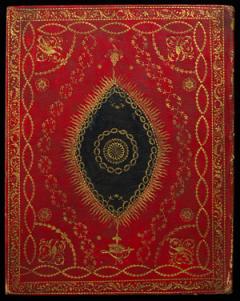Bindings
The structure and design of the physical book
Fine, important and interesting bookbindings are found throughout Special Collections. There are early Scottish bindings, including a contemporary binding on the copy of John Bellenden’s 'Hystory and croniklis of Scotland', printed on vellum about 1540 (Df.2.11). The collection is particularly strong in holdings of the late 16th century “shield binder”, believed to have worked in Edinburgh. The slightly later work of Andro Hart of Edinburgh is also represented. There are also royal bindings for King James VI and Mary Queen of Scots. During the 18th century, Scotland developed an outstanding tradition of decorative bookbinding, particularly on Bibles and prayer books, which were often given as wedding or christening presents. We have examples of distinctive Scottish “wheel” and “herringbone” bindings, plus bindings identified as the work of master binder James Scott. There are also examples of school prize bindings, “Mauchline”-style tourist souvenir bindings and theses bound in “Dutch” gilt decorated papers. Later examples of attractive publishers’ cloth bindings and designer dust-jackets can also be found.

We have a good number of armorial bindings, many now described in the online British Armorial Bindings database, produced by John Morris and Philip Oldfield. These include books from the library of Henry Sinclair, Bishop of Ross (1508-1565).
British Armorial Bindings database
There are also many fine foreign bindings showing a wide range of styles, materials and colours.
Many of our early bindings are described in W. S. Mitchell, 'A history of Scottish bookbinding' (1955); another useful source is John Durkan and Anthony Ross, 'Early Scottish libraries' (1961). Manual files and rubbings are available in the Centre for Research Collections.
Books which are acquired for their binding features are now kept together at shelfmark “Bdg.”

